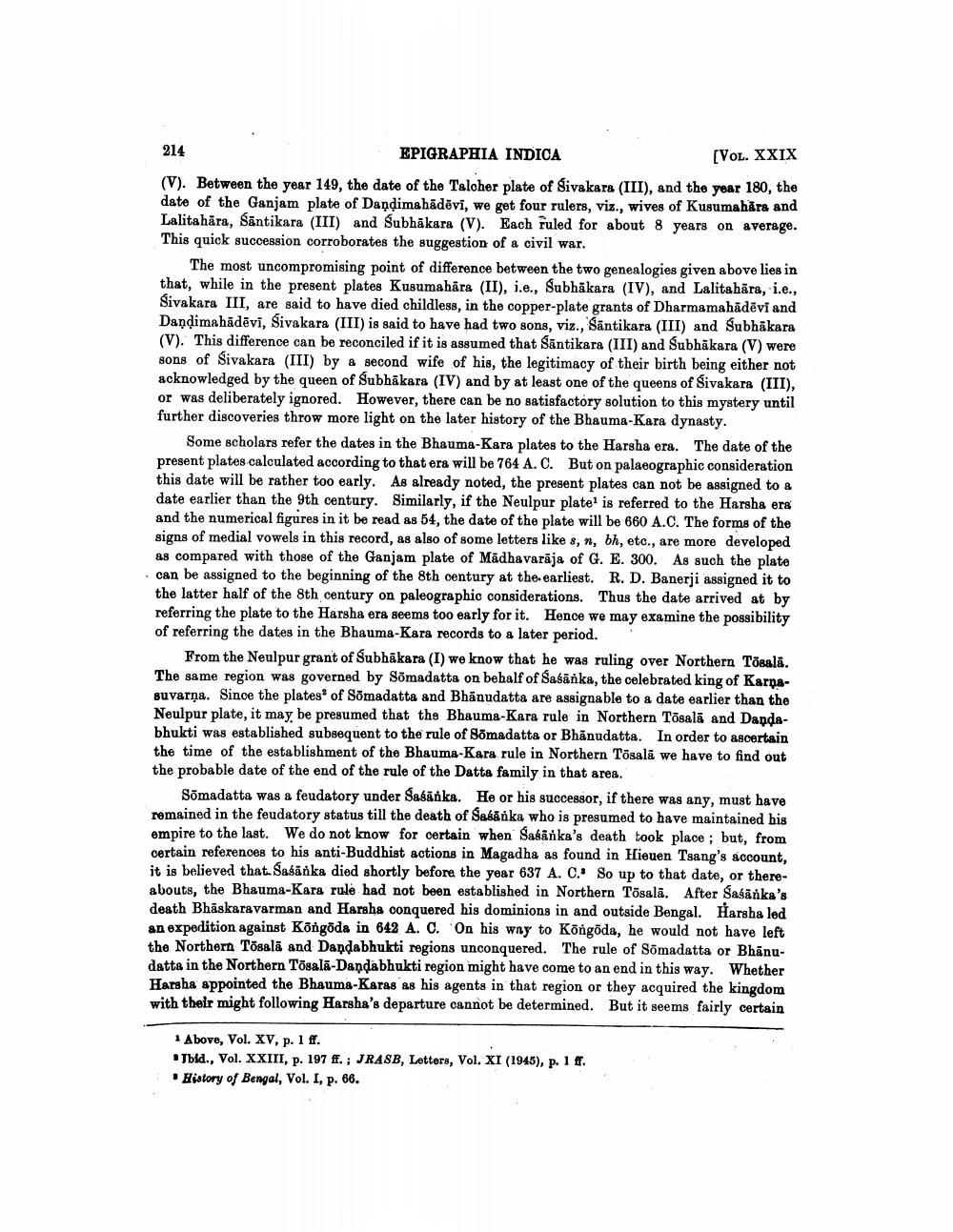________________
214 EPIGRAPHIA INDICA
[VOL. XXIX (V). Between the year 149, the date of the Talcher plate of Sivakara (III), and the year 180, the date of the Ganjam plate of Dandimahādēvi, we get four rulers, viz., wives of Kusumahāra and Lalitahara, Santikara (III) and Subhakara (V). Each ruled for about 8 years on average. This quick succession corroborates the suggestion of a civil war.
The most uncompromising point of difference between the two genealogies given above lies in that, while in the present plates Kusumahāra (II), i.e., Subhākara (IV), and Lalitahāra, i.e., Sivakara III, are said to have died childless, in the copper-plate grants of Dharmamahādēvi and Dandimahādēvi, Sivakara (III) is said to have had two sons, viz., Santikara (III) and Subhākara (V). This difference can be reconciled if it is assumed that Sāntikara (III) and Subhākara (V) were sons of Sivakara (III) by & second wife of his, the legitimacy of their birth being either not acknowledged by the queen of Subhākara (IV) and by at least one of the queens of Sivakara (III), or was deliberately ignored. However, there can be no satisfactory solution to this mystery until further discoveries throw more light on the later history of the Bhauma-Kara dynasty.
Some scholars refer the dates in the Bhauma-Kara plates to the Harsha era. The date of the present plates calculated according to that era will be 764 A. C. But on palaeographic consideration this date will be rather too early. As already noted, the present plates can not be assigned to a date earlier than the 9th century. Similarly, if the Neulpur plate' is referred to the Harsha era and the numerical figures in it be read as 54, the date of the plate will be 660 A.C. The forms of the signs of medial vowels in this record, as also of some letters like s, n, bh, etc., are more developed as compared with those of the Ganjam plate of Madhavarāja of G. E. 300. As such the plate can be assigned to the beginning of the 8th oentury at the earliest. R. D. Banerji assigned it to the latter half of the 8th century on paleographic considerations. Thus the date arrived at by referring the plate to the Harsha era seems too early for it. Hence we may examine the possibility of referring the dates in the Bhauma-Kara records to a later period.
From the Neulpur grant of Subhākara (I) we know that he was ruling over Northern Tõsalā. The same region was governed by Somadatta on behalf of Saśānka, the celebrated king of Karnasuvarna. Since the plates of Somadatta and Bhānudatta are assignable to a date earlier than the Neulpur plate, it may be presumed that the Bhauma-Kara rule in Northern Tõsalā and Dandabhukti was established subsequent to the rule of Sõmadatta or Bhānudatta. In order to ascertain the time of the establishment of the Bhauma-Kara rule in Northern Tõsalā we have to find out the probable date of the end of the rule of the Datta family in that area.
Sõmadatta was a feudatory under Saśāöka. He or his successor, if there was any, must have remained in the feudatory status till the death of Sakānka who is presumed to have maintained his empire to the last. We do not know for certain when Sabanka's death took place; but, from certain references to his anti-Buddhist actions in Magadha as found in Hieuen Tsang's account, it is believed that Sasänka died shortly before the year 637 A. C.' So up to that date, or thereabouts, the Bhauma-Kara rule had not been established in Northern Tõsalā. After Sasanka's death Bhāskaravarman and Harsha conquered his dominions in and outside Bengal. Harsha led an expedition against Kongöda in 642 A. O. 'On his way to Kongoda, he would not have left the Northern Tõgalā and Dandabhukti regions unconquered. The rule of Somadatta or Bhānudatta in the Northern Tösala-Dandabhukti region might have come to an end in this way. Whether Harsha appointed the Bhaums-Karas as his agents in that region or they acquired the kingdom with their might following Harsha's departure cannot be determined. But it seems fairly certain
1 Above, Vol. XV, p. 1 ff.
Tbid., Vol. XXIII, p. 197 ff.; JRASB, Letters, Vol. XI (1945), p. 1 ff. • History of Bengal, Vol. I, p. 66.




